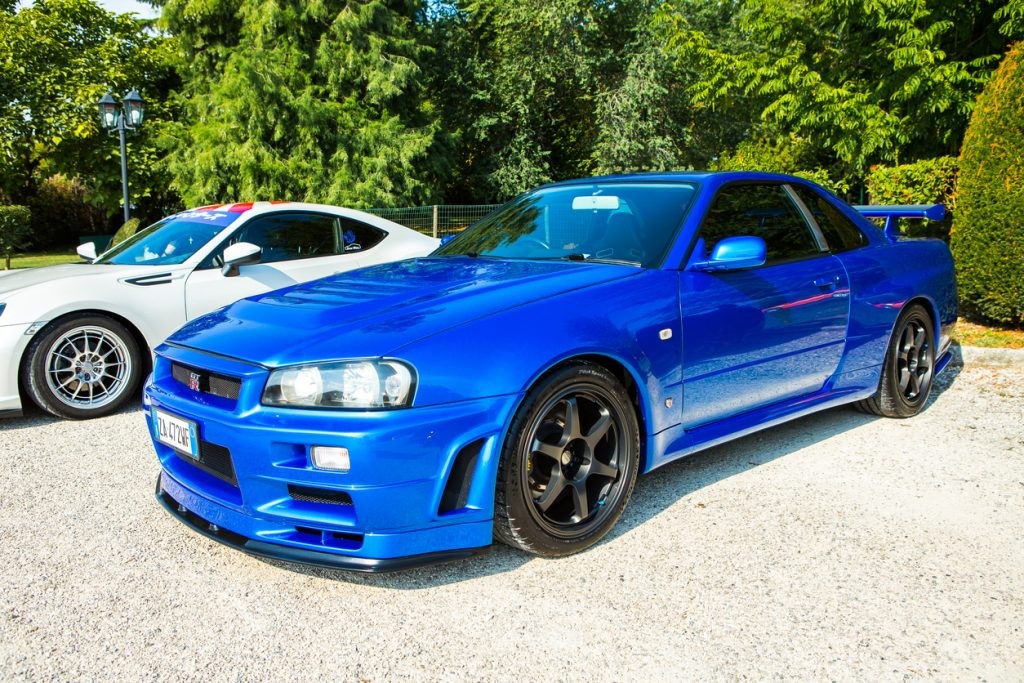In the realm of automotive excellence, where high-performance sports cars and supercars vie for supremacy, certain names resonate with enthusiasts worldwide. Among these iconic monikers, GT-R stands out, particularly in connection with the legendary Nissan Skyline GT-R. But What Does Gtr Stand For In Cars? The answer lies in its rich heritage and racing pedigree: GT-R is an abbreviation for Gran Turismo Racing. This designation signifies a vehicle engineered for high-speed touring and competition, blending exhilarating performance with advanced technology.
The Nissan Skyline GT-R has earned its place as a timeless icon through a potent combination of factors. Its powerful twin-turbo engine, coupled with a sophisticated all-wheel-drive system, delivers breathtaking performance on both the road and track. Furthermore, the GT-R’s consistent success in numerous touring car racing events solidified its legendary status and cemented the meaning of its name. For many car aficionados, GT-Rs are synonymous with the pinnacle of Japanese Domestic Market (JDM) automotive engineering and represent some of the most coveted high-performance vehicles ever produced.
The Evolution of the GT-R Legend: A Historical Perspective
The story of the GT-R badge begins in 1969 with the original Nissan Skyline GT-R. This first iteration was a rear-wheel-drive sedan, a departure from the all-wheel-drive monsters it would later become. Under the hood, it featured a naturally aspirated 2.0-liter DOHC inline-6 engine producing a respectable 160 horsepower. While not a tire-shredding beast by today’s standards, it laid the foundation for the GT-R legacy. The second-generation Skyline GT-R emerged in 1973, transitioning to a stylish two-door coupe body style, complete with a distinctive rear spoiler. However, its production run was tragically short-lived, lasting only a single year due to the global oil crisis and soaring fuel prices that dampened demand for performance cars.
The true GT-R revolution ignited with the arrival of the third-generation Skyline GT-R in 1989. This model, known as the R32, marked a paradigm shift. It was the first to incorporate a twin-turbocharged inline 6-cylinder engine and an advanced all-wheel-drive system known as ATTESA E-TS (Advanced Total Traction Engineering System for All-Terrain with Electronic Torque Split). Power output was a formidable 376 horsepower, launching the GT-R into a new performance stratosphere. A special edition, the Nissan GT-R Nismo (Nissan Motorsport), of this R32 generation, achieved legendary status by utterly dominating the Japanese Touring Car Championship race series. Its overwhelming track prowess and Japanese origin earned it the iconic nickname “Godzilla,” symbolizing its monstrous performance capabilities.
The lineage continued with the fourth-generation Skyline GT-R, the R33, debuting in 1994. It retained the successful formula of a twin-turbo inline 6-cylinder engine and all-wheel drive, refining and improving upon its predecessor’s performance. In 1999, the R34 GT-R arrived, representing the fifth generation and further advancing the GT-R legacy. This model introduced a six-speed manual transmission, replacing the previous five-speed, and featured a carbon fiber hood on the limited-production, high-performance V-Spec II version. Notably, the R34 was the final GT-R to bear the “Skyline” name, marking the end of an era and paving the way for a new chapter in the GT-R story.
The Modern GT-R: A Global Supercar
The latest iteration, the Nissan GT-R R35, broke new ground when it was unveiled in 2007 at the Tokyo Motor Show. For the first time, the GT-R was offered for sale globally, expanding its reach and appeal to a worldwide audience. The R35 also ushered in significant powertrain advancements, including the model’s first V6 engine, christened VR38DETT, and a cutting-edge dual-clutch transmission. This marked another milestone, as it was the first time an automatic transmission became available in a GT-R, broadening its accessibility without compromising performance.
The R35 GT-R solidified its supercar credentials with features like lightweight alloy wheels, powerful four-wheel Brembo brakes, and a launch control system for blistering acceleration. Inside, premium amenities such as advanced connectivity and a Bose audio system elevated the GT-R experience, blending raw performance with a touch of luxury. As Nissan’s flagship performance production car, the current GT-R R35 has been offered in numerous limited editions over its lifespan, including the track-focused Nismo, sleek Black Edition, and performance-oriented Track Edition variants, catering to diverse enthusiast preferences.
Power figures for the R35 GT-R have consistently climbed over the years, starting at 480 horsepower in the 2008 model and reaching 565 horsepower in later iterations. These impressive numbers have allowed the Nissan GT-R to remain competitive with established European supercars such as the Audi R8, Lamborghini Gallardo, McLaren 12C, and Porsche 911 Turbo in terms of acceleration, lap times, and top speed. Similar to the Chevrolet Corvette in the American market, the GT-R provides supercar-level performance at a significantly more accessible price point compared to its premium European rivals.
GT-R Beyond Nissan: A Symbol of High Performance
While Nissan’s association with the GT-R designation is the most prominent and enduring, other manufacturers have also employed these letters to denote high-performance models within their lineups. Notable examples include the McLaren F1 GTR, a racing variant of the legendary British mid-engine supercar of the 1990s, built for GT racing competitions. BMW produced a limited-production V8 version of the M3 in 2001 named the GTR, and Mercedes-Benz created the CLK GTR in the 1990s, a V12-powered, extreme performance machine. The current Mercedes-AMG GT R, powered by a potent 4.0-liter twin-turbo V8 engine producing over 500 horsepower, continues to uphold the GT-R performance tradition within the Mercedes-AMG family.
Like the Nissan GT-R, these other GT-R models are not designed for maximizing fuel economy or everyday practicality. Instead, they are engineered to deliver exhilarating driving experiences and track-ready performance. For those seeking the ultimate thrill behind the wheel, the GT-R badge, regardless of the manufacturer, represents a commitment to Gran Turismo Racing and a heritage of high-performance automotive engineering. These are cars built to excite, to push boundaries, and to remind us why we love driving.

